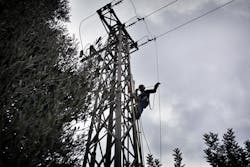As the largest power utility in the free world, Enel services some 73 million customers in 45 countries. To give you a frame of reference, there are only about 100 million customers in all of the U.S.—serviced by 3,200 different utilities.
Given that, the need for Enel to be the incredibly well-run and forward-thinking entity that it is should not be a surprise. For the operation of more than 2 million km of power distribution networks, Enel adopted automation “early and comprehensively,” according to Ed Abbo, president and CTO of C3, an artificial intelligence (AI) software provider that has recently ratcheted its work with the power giant to a new level. More than 85 percent of Enel’s power networks are fully automated, he notes, so that any time there’s a failure at a node, power is automatically routed around it.
Enel has been collaborating with C3 for five years, initially deploying applications on public cloud infrastructure to ingest data from tens of millions of smart meters and sensors to drive business value, Abbo says. C3 is now providing Enel with the C3 AI Suite, a range of AI and smart grid analytics applications that recently allowed Enel to deploy the Enel Unified Virtual Data Lake, integrating data across its retail, distribution, trading, renewables and conventional generation businesses. The C3 AI Suite integrates, aggregates and makes available unified data across enterprise resource planning (ERP), human resources, financial and operational systems—including SAP Hana, Oracle, Siemens, PostGreSQL, MongoDB and Cloudera—to enable and deliver next-generation AI applications across Enel’s business.
“This announcement is really a step function change in how Enel is using the C3 technology,” Abbo explains. “What they’ve now done is hired and trained their data scientists and app developers to use the C3 AI Studio to design, develop and deploy into operation their own machine learning applications across Enel.”
Essentially, Enel has gone from subscribing to prebuilt C3 software-as-a-service (SaaS) apps to developing their own machine learning apps across the company.
“The significance of this is that they’re actually driving a digitalization strategy as part of their corporate strategy. They have targets for driving operational efficiency and customer engagements. They’re looking to drive over€2 billion in earnings improvements over the next two to three years,” Abbo says. “Enel is not only a leader in technology but also a leader in digital transformation. They have the know-how to execute on the technology side but also on the change management.”
Implementing AI and machine learning is actually the straightforward part, Abbo notes. Aggregating the data from the various siloed systems and assembling that data, with its differing formats, identifiers, etc., “is an enormous challenge and undertaking.” Data fragmentation makes it difficult to really optimize the whole.
This is where the data lake comes in. “The Unified Virtual Data Lake is the deployment of C3 AI Studio to aggregate data from numerous systems and data lakes that might already be in place,” Abbo says. AI Studio presents a consistent view of everything from power generation to distribution and navigates the multiplicity of underlying systems that contain that data. “As an end user, I don’t have to worry about where the data might be located or the correlation of those data across those systems. All I need to do is query the virtualized data lake. The lake does the heavy lifting to access data and deal with the inequality issue.”
The C3 AI Suite allows Enel to provide its developers, data scientists and business analysts one common and secure view of all of its data, enabling them to collaborate and rapidly develop AI applications.
“Leveraging the power of AI and IoT [Internet of Things] is key for Enel to achieve its digital transformation, while allowing tremendous benefits to be delivered to its customers and shareholders,” says Fabio Veronese, head of infrastructure and networks digital hub at Enel. “The collaboration with C3 is allowing us to harness innovative business processes enabled by Big Data analytics, unleashing a new era of operational efficiencies that strengthen our position as leader of the energy transition.”
The collaboration enables Enel’s aggregation of large volumes of real-time data and the development and execution of the thousands of algorithms needed to analyze those data and generate millions of predictions daily—all designed to increase the speed and accuracy of Enel’s operational decision-making.
As the power grid shifts from central generation and very predictable demand to a complex system that includes less predictable renewable energies and shifting demands, power companies are spending several trillion dollars this decade to invest in automation across the entire grid, Abbo says. Sensors and actuators are being deployed throughout the system. “The other layer is exactly what Enel is putting into place—the ability to adjust data from these sensors and do a better job of forecasting demand down to each customer using machine learning,” he says. “Machine learning is being deployed at customer endpoints. They can aggregate the data and can forecast supply, which is increasingly renewable. Then they can send the right price signal to curtail demand to meet supply.”
Enel is leading the path to bring the smart grid vision to reality, Abbo comments. With Enel viewed as a thought leader within the power business, others are taking note of the dramatic efficiencies to be gained.
Leaders relevant to this article:

